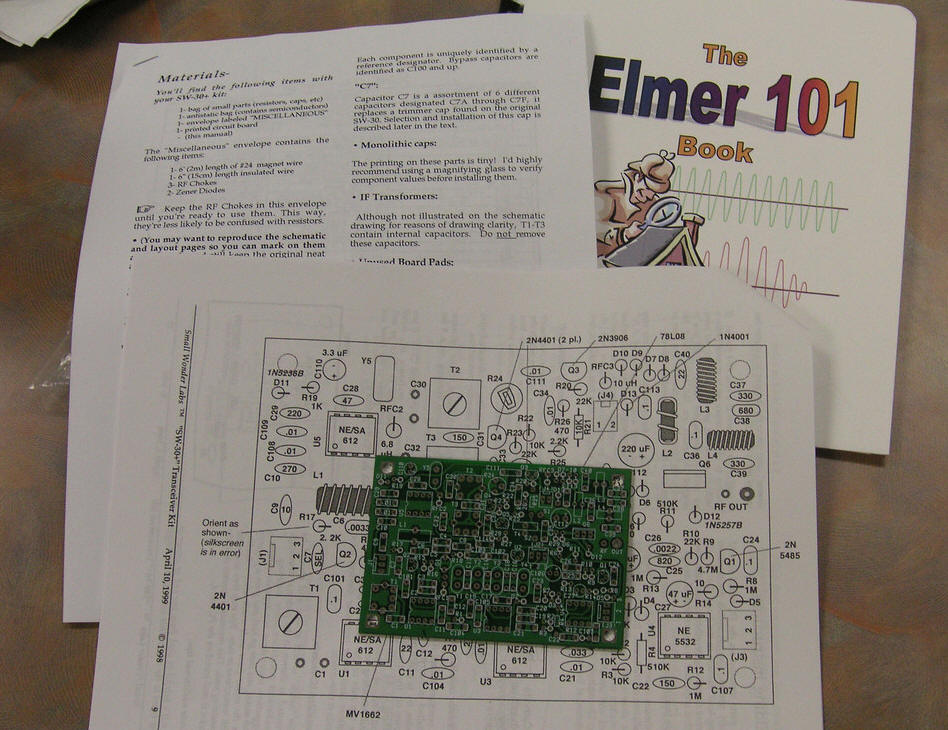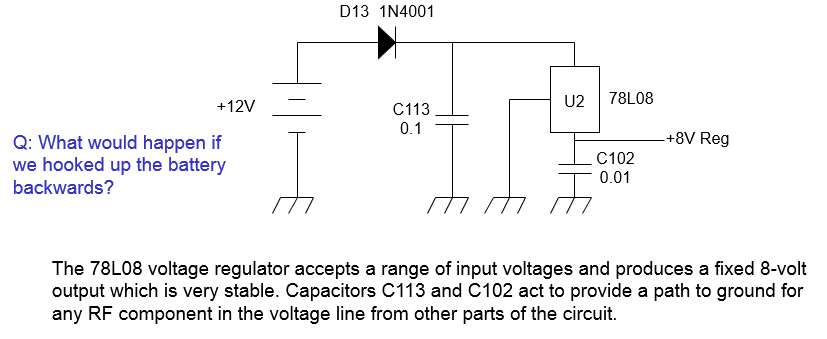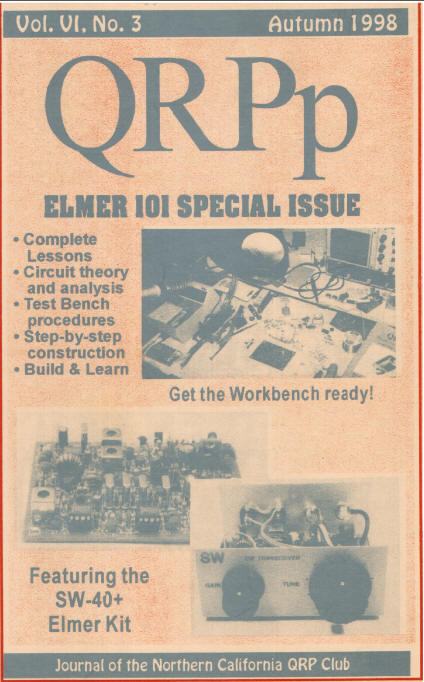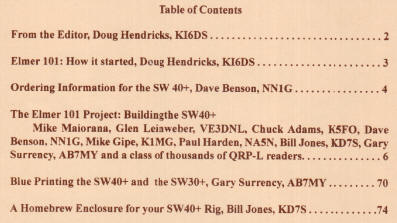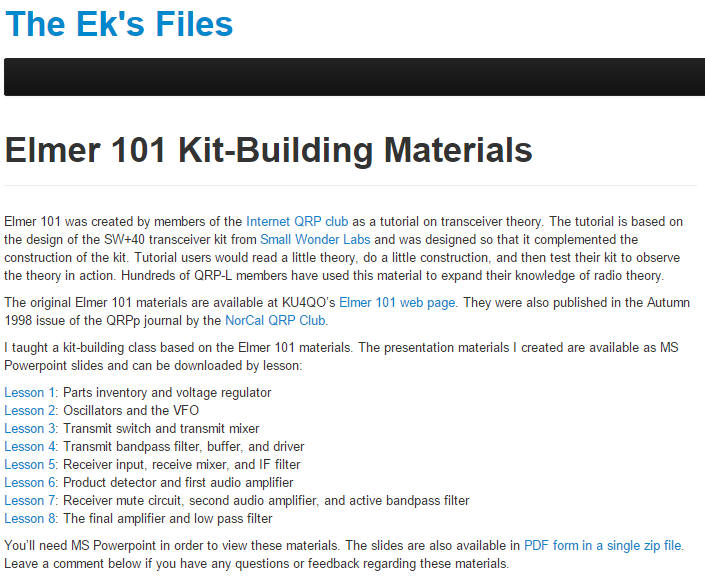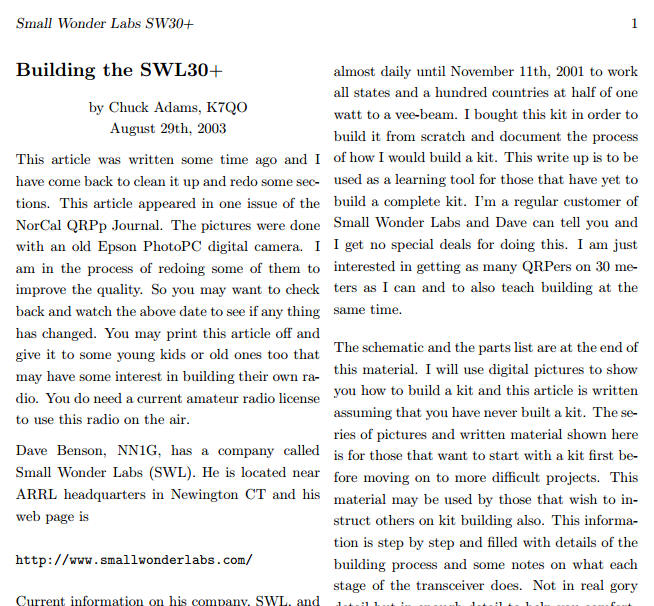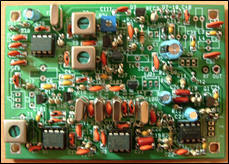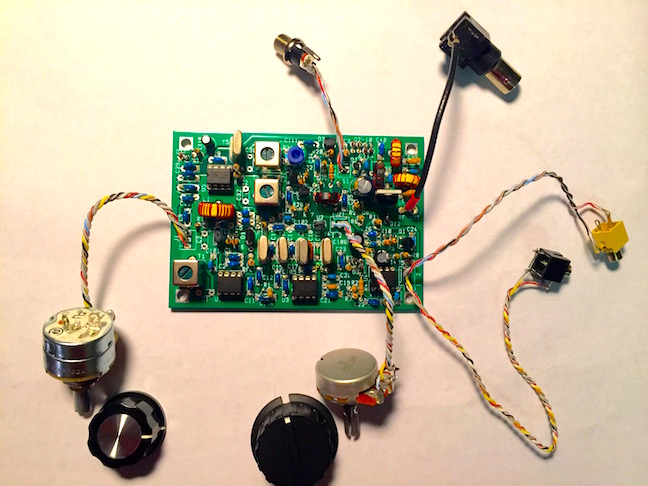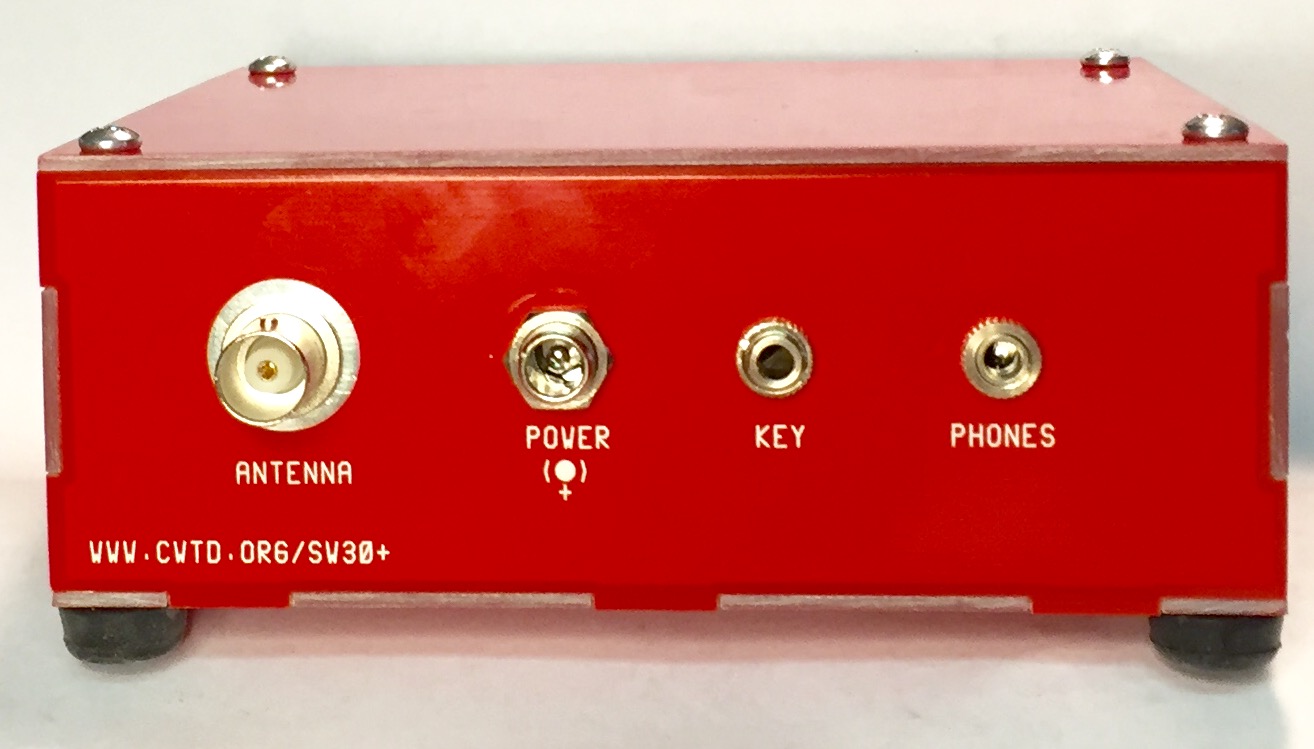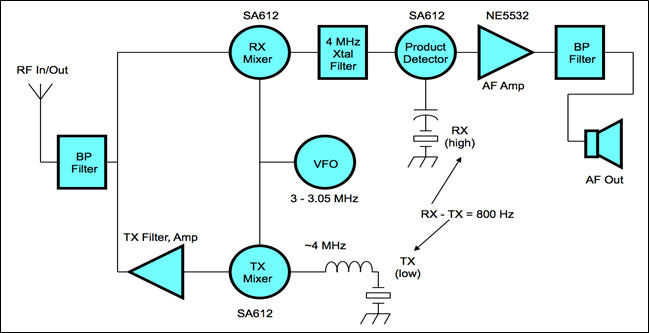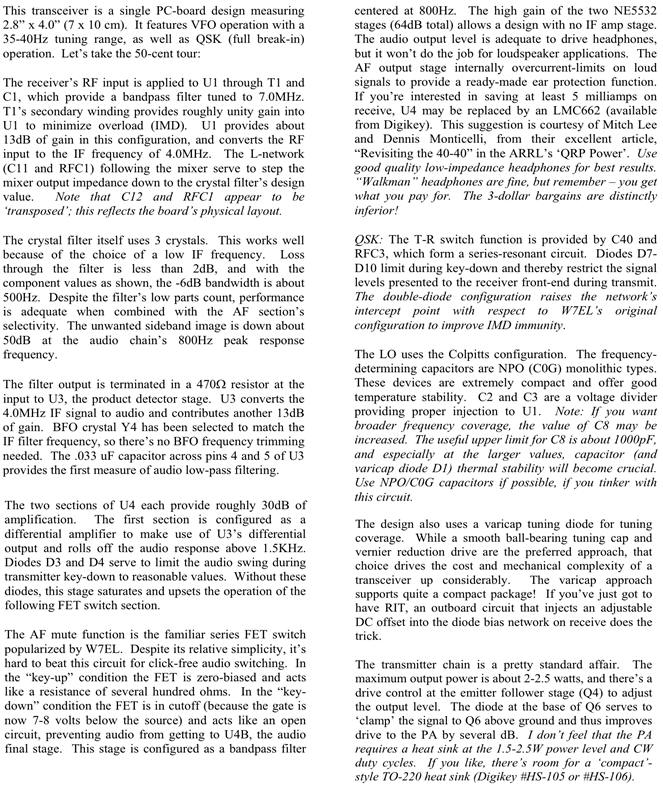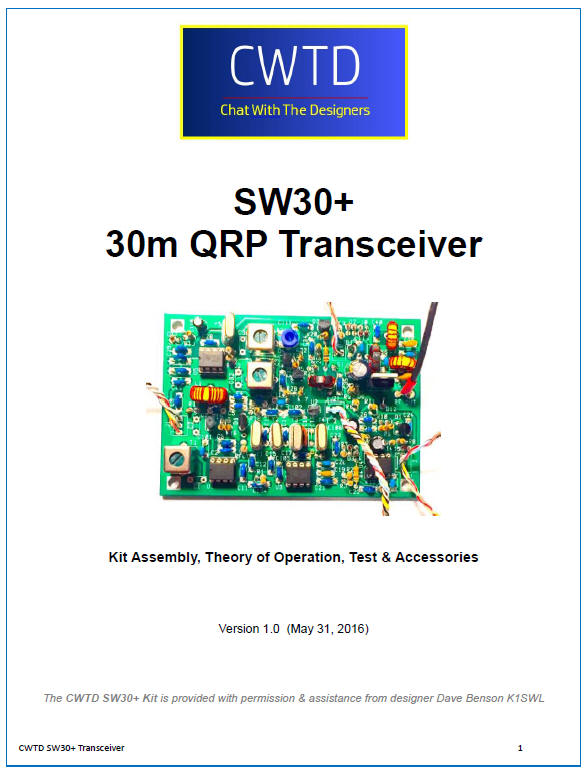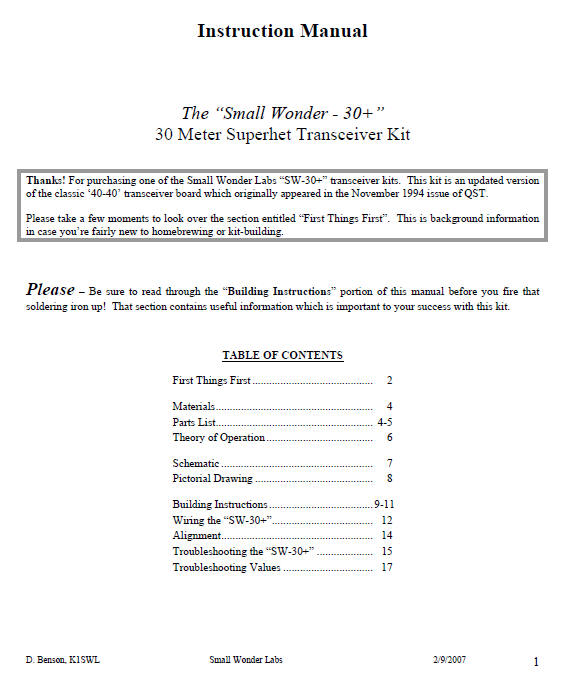May 31, 2016
Elmer 101
and the Small Wonder Labs SW30+ Transceiver
Understand the basics of this classic monoband superhet ... and build up the kit here with us all in successive episodes of CWTD!
Limited-run kitting of the classic 2-watt 30-meter superhet transceiver
by designer Dave Benson K1SWL of Small Wonder Labs.
Overview
Welcome to the kickoff episode of our Elmer 101 series!. In these informative, instructional and interactive sessions we will be chronicling the design, construction and analysis of the famous SW30+ Transceiver by Dave Benson, K1SWL.
We're launching the unofficial start of summer in our own very cool way!In this first episode we will cover ...
1) The Elmer 101 approach ... how we'll cover all the great material in many follow-on episodes;
2) Available documents ... many great ones are already available, and we have a killer addition to the pool;
3) CWTD SW30+ Kit Overview ... and a walk-thru of parts inventory;
4) Great accessories ... enclosure, frequency display, keyer;
5) Ordering window opens!
With so much great material to get through, and to help kit builders along with timely guidance, we'll be having CWTD episodes on an every-other-Tuesday basis (or more!) ... and this may become the norm again even after we conclude the series. There's lots of super interesting technologies, parts and projects available to homebrewing & experimenting hams, and we're excited about being involved with it all and helping others along.Many great instructional references were published several years ago and we’ll be paralleling portions of each as we ramp up CWTD participants and podcasters on the theory and design of the project, while stage-by-stage building Dave Benson’s K1SWL classic little 30m kit. (A limited run of the SW30 Kit is being done for CWTDers, with permission and assistance from K1SWL.)
So let's start exploring the basics of radio design in this series … and then reach for the stars!
CWTD Episode #78: Elmer 101 and the SW30+ Transceiver
Elmer 101 - Learning Theory for Fun ... from the web pages of Jim Larsen, AL7FS ... http://www.al7fs.us/AL7FS3.html ...THANK YOU JIM!
In the early days of winter 1997 - 1998, there were QRP Operators on the QRP-L Mail List that were wanting a fun transceiver project that was more than just plugging in parts on a board. They wanted to learn from the experience and they wanted to help other hams, new and old, to learn the theory behind the QRP transceiver. A general call went out to the list for knowledgeable hams to act as Elmers (Elmers: Hams who help hams or prospective hams with technical or other issues) for the building of a 40 meter QRP CW transceiver.
One of the exciting aspects of the QRP-L Mail List (information near the end of this article) is that a large number of the people that you have seen writing articles (for ham radio magazines) over the years hang out on QRP-L. These technically savvy hams raised their collective hands and volunteered to author course material for the building of a transceiver. In the end, the primary authors of the SW40+ overview and course details were Mike Maiorana KU4QO (ex. KF4TRD) and Glen Leinweber, VE3DNL. The course was dubbed Elmer 101.
The only thing left to do was to decide on which QRP transceiver kit would become the centerpiece of the Elmer 101 course. After much interesting discussion on QRP-L, Dave Benson, NN1G, of Small Wonder Labs, offered to update and improve his already well-known classic SW40 CW QRP transceiver. (The SW40 design was published in the November 1994 issue of QST and serves as a centerpiece in the ARRL's anthology, "QRP Power".)
The circuit and thus the PCB (printed circuit board) were upgraded and the kit was offered at $50 (currently $55 (postpaid) to US) (Did not include the cabinet and chassis mounted wiring and parts) for the class members. This tiny little 2-watt CW transceiver had already proven to be a real performer and now it was even better. The rig was renamed the SW40+.
Getting Started
Elmer 101 began with a list of prerequisites for each prospective "student" to study as preparation for the actual course. Then, slowly, at a pace geared to allow each student to build and learn, the course unfolded.
I was fortunate to be subscribed to the QRP-L mail list during the development and rollout of the Elmer 101 course. I had been a ham operator for over 32 years, had passed my Amateur Extra Class tests, but in spite of all this opportunity, I still did not understand the inner workings of a modern day CW transceiver. This approach to learning was to be one of the most exciting periods of my ham career.
The prerequisites had me actually reading and studying from the ARRL Amateur Radio Handbook. This material kept me plenty busy as I ordered and waited for delivery of my Small Wonder Labs SW40+ kit. By the time the kit arrived I was ready to begin studying each chapter of the Elmer 101 course. The basic approach was to read the theory, relate it to the schematic and then build and test that section of the transceiver.
The beauty of this course was that if you got stuck or needed help in any way, you could ask the question to the entire QRP-L Mail List group. Always, the answer would be posted in terms designed to help each student grow. (This help is still there today!)
Day-by-day and week-by-week, the theory began to grow in my head. The transceiver grew section by section. The transmitter section was scheduled into the process such that it could be used to test the receiver sections. Gradually, the mystery of a CW transceiver was reduced to such a level that I could enjoy looking at a schematic without getting too frustrated. I had finally learned theory and married it to practice.
Today, the Elmer 101 class is complete. Many SW40+ transceivers have been built and are now operating on the air. This little rig from Small Wonder Labs is available in mono-band form for 80, 40, 30 and 20 meters. While I built mine for the class target band of 40 meters in the Elmer 101 course, I think the 20-meter version would be especially useful for hams in Alaska. This rig costs only $55 postpaid in the US. You can provide all your own chassis parts and chassis or an enclosure kit (shown above with customized labeling) is also available at $35 plus $3 shipping and comes with all harnesses, connectors and controls. As discovered on my business trips to the Lower 48 states, it is a real performer. I have had successful contacts right from my hotel room with a long-wire antenna dropped out of the window.
Sample "Elmering" info on the circuits ...
"Elmer 101" & SW-xx Building Resources
KU4QO’s Elmer 101 web page.
"We have separated the construction of the SW-40+ kit into functional blocks.
Each part is posted to the QRP-L list and then discussed online.
Below are the links to the different sections archived."
Elmer 101 Special Issue, QRPp magazine from Autumn 1998 ... http://www.ncqrpp.org/files/qrpp_volume_06.pdf
Starts at page 140 in this large PDF download.
87 pages of assembly guidance, background and theory!
The Eks Files ... http://eksfiles.net/elmer-101-kit-building-materials/
Chuck Adams, K7QO did his usual excellent homebrewing and construction renditions with this version of his build-up of the SW30 Kit.
... available for download at Chuck's site ... http://www.k7qo.net/swl30p.pdf
CWTD reprise of the "SW30+" Kit

Specifications
Here's the overview of this family's design features:
- Single-board transceiver, 2.8 x 4.0" (7 x 10.1 cm)
- Commercial-quality board, masked and silkscreened
- True VFO: 35-40 khz coverage [SW30: 10.1-10.135 MHZ]
- Superheterodyne design, with crystal filtering
- Quiet solid-state T-R switching (QSK)
- Output Power Adjustable- 2.5W max.
Uses straight key & headphones
3-crystal IF filter at 4 MHz
Kit uses all thru-hole parts
Kit provides matched crystals
The SW+ series retains much of the original "40-40" receiver design, while augmenting the transmitter design for improved stability and output power. The following design changes went into making a classic even better:
- Added power supply reverse-polarity diode
- The number of toroids to wind drops from 8 (in the original) to 5. This pays off in faster and simpler assembly.
- The diode bridge T-R switch is replaced by a series L-C type. This drops receiver current draw from 22 to 16 mA and improves image rejection.
- The crystal filter is changed from 2 to 3 crystals for improved skirt selectivity. A grounding point for the crystal cases is also provided to reduce filter 'blow-by'. For the 30M version, the IF has been changed. This relocates the image response to virtually eliminate SWBC pickup.
- Replaced a number of local oscillator components for improved reliability and stability.
- The PA is a T0-220 device, capable of more output power than the original. Should you wish to modify the design slightly for more power, there's now space for a TO-220 heatsink.
- The interconnects have been functionally-grouped. The board kit-only builder may wire directly to the board in convenient wiring groups. The companion enclosure kit provides locking .100" headers, with pre-assembled harnesses. The new board is 'drop-in compatible' with prior versions of the SW-series enclosure kit.
- The printed-circuit board is now double-sided and solder-masked both sides. Component silkscreening is improved, and all parts are identified on the silkscreen by both outlines and reference designators.
Block Diagram
Theory of Operation
Schematic
Board Layout
CWTD SW30+ Manual ...
Dave's original manyual ...

